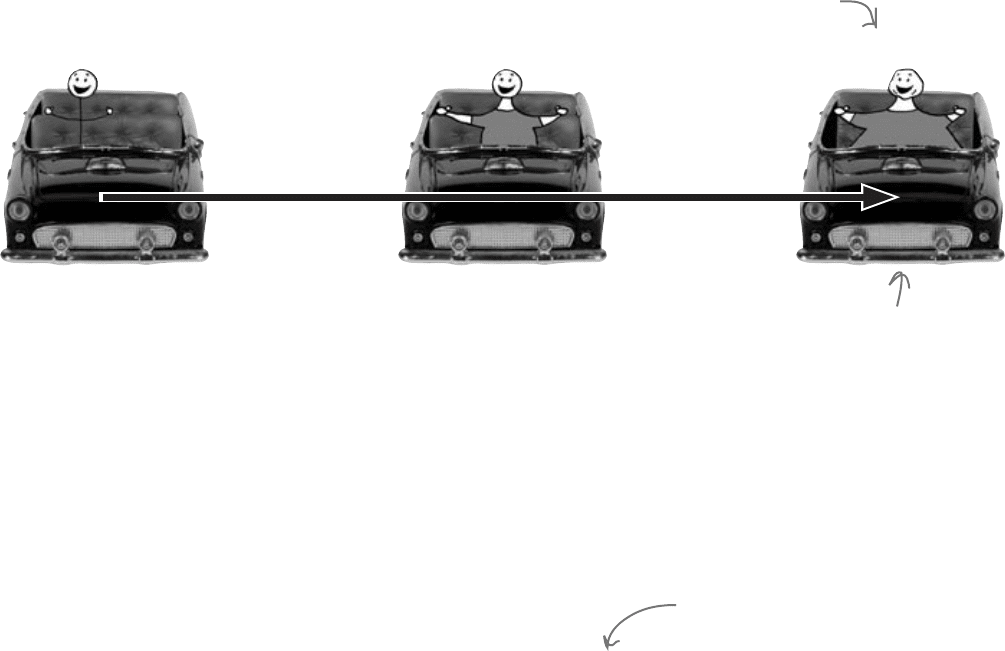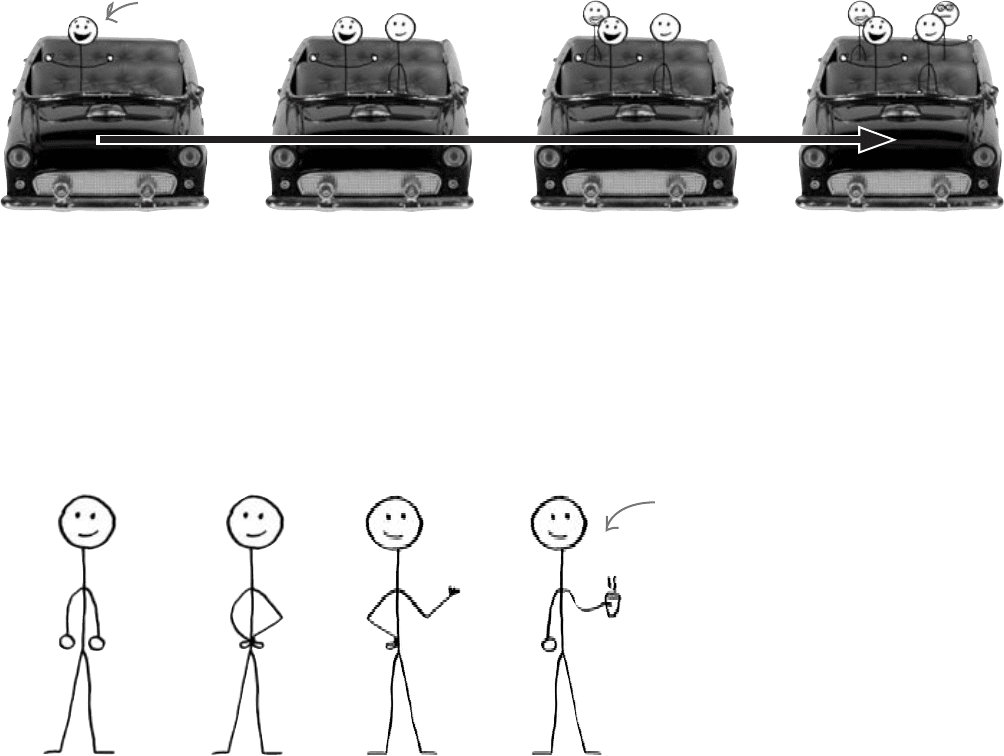Griffiths D. Head First Statistics
Подождите немного. Документ загружается.


you are here 4 371
using the normal distribution ii
Find the probability that the combined weight of the bride and
groom is less than 380 pounds using the following three steps.
1. X is the weight of the bride and Y is the weight of the groom, where X ~ N(150, 400) and Y ~ N(190, 500). With this
information, find the probability distribution for the combined weight of the bride and groom.
2. Then, using this distribution, find the standard score of 380 pounds.
3. Finally, use the standard score to find P(X + Y < 380).

372 Chapter 9
Find the probability that the combined weight of the bride and
groom is less than 380 pounds using the following three steps.
1. X is the weight of the bride and Y is the weight of the groom, where X ~ N(150, 400) and Y ~ N(190, 500). With this
information, find the probability distribution for the combined weight of the bride and groom.
We need to find the probability distribution of X + Y. To find the mean and variance of X + Y, we add
the means and variances of the X and Y distributions together. This gives us
X + Y ~ N(340, 900)
2. Then, using this distribution, find the standard score of 380 pounds.
z = (x + y) - μ
= 380 - 340
30
= 40
30
= 1.33 (to 2 decimal places)
3. Finally, use the standard score to find P(X + Y < 380)
If we look 1.33 up in standard normal probability tables, we get a probability of 0.9082. This means that
P(X + Y < 380) = 0.9082
Remember how before we used z = x - μ ?
σ
This time around we’re using the distribution
of X + Y, so we use z = (x + y) - μ
σ
sharpen solution
σ

you are here 4 373
using the normal distribution ii
Julie’s matchmaker is at it again. What’s the probability that a man will be at least 5 inches taller
than a woman?
In Statsville, the height of men in inches is distributed as N(71, 20.25), and the height of women
in inches is distributed as N(64, 16).

374 Chapter 9
Julie’s matchmaker is at it again. What’s the probability that a man will be at least 5 inches taller
than a woman?
In Statsville, the height of men in inches is distributed as N(71, 20.25), and the height of women
in inches is distributed as N(64, 16).
Let’s use X to represent the height of the men and Y to represent the height of the women. This means that
X ~ N(71, 20.25) and Y ~ N(64, 16).
We need to find the probability that a man is at least 5 inshes taller than a woman. This means we need to find
P(X > Y + 5)
or
P(X - Y > 5)
To find the mean and variance of X - Y, we take the mean of Y from the mean of X, and add the variances
together. This gives us
X - Y ~ N(7, 36.25)
We need to find the standard score of 5 inches
z = (x - y) - μ
σ
= 5 - 7
6.02
= -0.33 (t
o 2 decima
l places)
We can use this to find P(X - Y > 5).
P(X - Y > 5) = 1 - P(X - Y < 5)
= 1 - 0.3707
= 0.6293
exercise solution

you are here 4 375
using the normal distribution ii
More people want the Love Train
It looks like there’s a good chance that the combined weight of the happy
couple will be less than the maximum the ride can take. But why restrict
the ride to the bride and groom?
Let’s see what happens if we add another car for four more members of
the wedding party. These could be parents, bridesmaids, or anyone else
the bride and groom want along for the ride.
The car will hold a total weight of 800 pounds, and we’ll assume the
weight of an adult in pounds is distributed as
X ~ N(180, 625)
where X represents the weight of an adult. But how can we work out the
probability that the combined weight of four adults will be less than 800
pounds?
Think back to the shortcuts you can use when you calculate expectation
and variance. What’s the difference between independent observations and
linear transformations? What effect does each have on the expectation and
variance? Which is more appropriate for this problem?
Customers are demanding
that we allow more members of the
wedding party to join the ride, and
they’ll pay good money. That’s great, but
will the Love Train be able to handle
the extra load?

376 Chapter 9
Let’s start off by looking at the probability distribution of 4X, where X is
the weight of one adult. Is 4X appropriate for describing the probability
distribution for the weight of 4 people?
The distribution of 4X is actually a linear transform of X. It’s a
transformation of X in the form aX + b, where a is equal to 4, and b is equal
to 0. This is exactly the same sort of transform as we encountered earlier with
discrete probability distributions.
Linear transforms describe underlying changes to the size of the values in the
probability distribution. This means that 4X actually describes the weight of
an individual adult whose weight has been multiplied by 4.
So what’s the distribution of a linear transform?
Suppose you have a linear transform of X in the form aX + b, where
X ~ N(μ, σ
2
). As X is distributed normally, this means that aX + b is distributed
normally too. But what’s the expectation and variance?
Let’s start with the expectation. When we looked at discrete probability
distributions, we found that E(aX + b) = aE(X) + b. Now, X follows a normal
distribution where E(X) = μ, so this gives us E(aX + b) = aμ + b.
We can take a similar approach with the variance. When we looked at discrete
probability distributions, we found that Var(aX + b) = a
2
Var(X). We know that
Var(X) in this case is given by Var(X) = σ
2
, so this means that Var(aX + b) = a
2
σ
2
.
Putting both of these together gives us
aX + b ~ N(aμ + b, a
2
σ
2
)
The new variance is the SQUARE
of a multiplied by the original
variance.
In other words, the new mean becomes aμ + b, and the new variance becomes a
2
σ
2
.
So what about independent observations?
1X
2X
4X
The 4X probability
distribution describes
adults whose weights have
been multiplied by 4. The
weight is changed, not the
number of adults.
Linear transforms describe underlying changes in values…
What we wanted was 4 adults,
not 1 adult 4 times actual size.
linear transforms vs. independent observations

you are here 4 377
using the normal distribution ii
Rather than transforming the weight of each adult, what we really need
to figure out is the probability distribution for the combined weight of
four separate adults. In other words, we need to work out the probability
distribution of four independent observations of X.
The weight of each adult is an observation of X, so this means that the
weight of each adult is described by the probability distribution of X. We
need to find the probability distribution of four independent observations of
X, so this means we need to find the probability distribution of
X
1
+ X
2
+ X
3
+ X
4
where X
1
, X
2
, X
3
and X
4
are independent observations of X.
Each adult’s weight is an
independent observation of X.
Each adult is an independent
observation of X.
X X + X X + X + X X + X + X + X
X
1
X
2
X
3
X
4
…and independent observations describe how many values you have

378 Chapter 9
When we looked at the expectation and variance of independent observations of
discrete random variables, we found that
E(X
1
+ X
2
+ ... X
n
) = nE(X)
and
Var(X
1
+ X
2
+ ... + X
n
) = nVar(X)
As you’d expect, these same calculations work for continuous random variables too.
This means that if X ~ N(μ, σ
2
), then
X
1
+ X
2
+ ... + X
n
~ N(nμ, nσ
2
)
Q:
So what’s the difference between
linear transforms and independent
observations?
A: Linear transforms affect the underlying
values in your probability distribution. As
an example, if you have a length of rope of
a particular length, then applying a linear
transform affects the length of the rope.
Independent observations have to do with
the quantity of things you’re dealing with.
As an example, if you have n independent
observations of a piece of rope, then you’re
talking about n pieces of rope.
In general, if the quantity changes, you’re
dealing with independent observations. If the
underlying values change, then you’re dealing
with a transform.
Q:
Do I really have to know which is
which? What difference does it make?
A: You have to know which is which
because it make a difference in your
probability calculations. You calculate
the expectation for linear transforms and
independent observations in the same
way, but there’s a big difference in the way
the variance is calculated. If you have n
independent observations then the variance
is n times the original. If you transform your
probability distribution as aX + b, then your
variance becomes a
2
times the original.
Q:
Can I have both independent
observations and linear transforms in the
same probability distribution?
A: Yes you can. To work out the probability
distribution, just follow the basic rules for
calculating expectation and variance. You
use the same rules for both discrete and
continuous probability distributions.
If X ~ N(μ
x
, σ
2
x
) and
Y ~ N(μ
y
, σ
2
y
), and X and Y
are independent, then
X + Y ~ N(μ
x
+ μ
y
, σ
2
x
+ σ
2
y
)
X - Y ~ N(μ
x
- μ
y
, σ
2
x
+ σ
2
y
)
If X ~ N(μ, σ
2
) and a and b are
numbers, then
aX + b ~ N(aμ + b, a
2
σ
2
)
If X
1
, X
2
, ..., X
n
are
independent observations of
X where X ~ N(μ, σ
2
), then
X
1
+ X
2
+ ... + X
n
~ N(nμ, nσ
2
)
finding expectation and variance
Expectation and variance for independent observations

you are here 4 379
using the normal distribution ii
Let’s solve Dexter’s Love Train dilemma. What’s the probability that the combined weight of 4
adults will be less than 800 pounds? Assume the weight of an sdult is distributed as N(180, 625).

380 WHO WANTS TO WIN A SWIVEL CHAIR
Let’s solve Dexter’s Love Train dilemma. What’s the probability that the combined weight of 4
adults will be less than 800 pounds? Assume the weight of an sdult is distributed as N(180, 625).
If we represent the weight of an adult as X, then X ~ N(180, 625). We need to start by finding
how the weight of 4 adults is distributed. To find the mean and variance of this new distribution,
we multiply the mean and variance of X by 4. This gives us
X
1
+ X
2
+ X
3
+ X
4
~ N(720, 2500)
To find P(X
1
+ X
2
+ X
3
+ X
4
< 800), we start by finding the standard score.
z = x - μ
= 800 - 720
50
= 80
50
= 1.6
Looking this value up in standard normal probability tables gives us a value of 0.9452. This means
that
P(X
1
+ X
2
+ X
3
+ X
4
< 800) = 0.9452
exercise solution
σ
